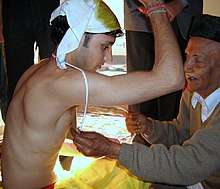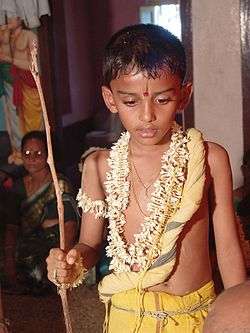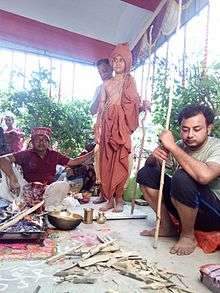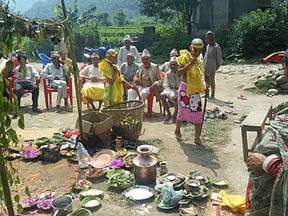Upanayana
Upanayana (Sanskrit: उपनयन upanayana-) Janai or janeau (Sanskrit: जनै, जनेऊ is one of the traditional saṃskāras (rites of passage) that marked the acceptance of a student by a guru (teacher or tutor) and an individual's entrance to a school in Hinduism. The tradition is widely discussed in ancient Sanskrit texts of Hinduism and varies regionally.[2] The sacred thread (yagyopavita or janeu) is received by the boy during this ceremony, that he continues wearing from left shoulder to the right crossing the chest thereafter. Generally this ceremony should be done before the age of 16.

The upanayana was restricted in many medieval Hindu texts to the upper three of the four varnas (castes) of society — brahmins, kshatriyas and vaishyas. However, Vedic period texts such as the Baudhāyana Grihyasutra encouraged all members of society to undergo the upanayana, even (manual workers) shudras.[3][4][5] Women were encouraged to undergo upanayana in Bharat (present day India) and Gorkha Kingdom (present day Nepal) before they started Vedic studies or before their wedding.[6]
Etymology
Upanayana (Sanskrit: उपनयन) literally means "the act of leading to or enlightment or near the eye (or eyesight / vision/ Third eye/ Pineal gland)".[7] It is an important and widely discussed samskara in ancient Sanskrit texts.[2] The rite of passage symbolizes the leading or drawing towards the self of a child, in a school, by a teacher.[7] It is a ceremony in which a guru (teacher) accepts and draws a child towards knowledge and initiates the second birth that is of the young mind and spirit.[2]
Description

Upanayana is the rite of passage for the start of formal education of writing, numbers, reading, Vedangas, arts and other skills.[8] The Upanayana rite of passage was also important to the teacher, as the student would therefrom begin to live in the gurukul (school).[2]
Upanayana is an elaborate ceremony, that includes rituals involving the family, the child and the teacher. A boy receives during this ceremony a sacred thread called Yajñopaveetam that he wears. The Yajñopavita ceremony announce that the child had entered into formal education.[9][10] In the modern era, the Upanayana rite of passage is open to anyone at any age.[1]
The education of a student was not limited to ritual and philosophical speculations found in the Vedas and the Upanishads. They extended to many arts and crafts, which had their own, similar rites of passages.[11] Aitareya Brahmana, Agamas and Puranas literature of Hinduism describe these as Śilpa Śastras. They extend to all practical aspects of culture, such as the sculptor, the potter, the perfumer, the wheelwright, the painter, the weaver, the architect, the dancer, and the musician. Ancient Indian texts assert that the number of the arts is unlimited, but each deploy elements of 64 ‘‘kala’’ (कला, techniques) and 32 ‘‘vidyas’’ (विद्या, fields of knowledge).[11] The training of these began from childhood and included studies about dharma, culture, reading, writing, mathematics, geometry, colors, tools, as well as traditions (trade secrets). The rites of passage during apprentice education varied in the respective guilds.[4][12]
Rajbali Pandey compares the Upanayana rite of passage to Baptism in Christianity where the person is born again unto spiritual knowledge, as the ceremony marked the initiation of the student for spiritual studies such as the Vedas.[8]
Age, gender and varna restrictions

In Hindu traditions, a human being is born at least twice — once at physical birth and second at intellectual birth through teacher's care. The first is marked through the Jatakarman sanskara ritual; the second is marked through Upanayanam or Vidyarambha rites of passage.[13][14] A sacred thread was given by the teacher during the initiation to school ceremony and was a symbolic reminder to the student of his purpose at school as well as a social marker of the student as someone who was born a second time (dvija, twice born); he went about collecting fire wood in forests and food donations from villages on a daily basis.[15][16]
Many medieval era texts discuss Upanayana in the context of three varnas (caste, class) — Brahmins, Kshtreyas and Vaishyas.[8] Several texts such as Sushruta Sutrasthana, however, also include Sudras entering schools and the formal education process,[17] stating that the Upanayana samskara was open to everyone.[5][9] The Baudhayana Grihya sutra in verses 2.5.8 and 2.5.9 states the teacher to "[l]et him initiate [to school through Upanayana] a Brahmin in spring, a Kshatriya in summer, a Vaishya in autumn, a Sudra in the rainy season; or all of them in the spring."[3]
The ceremony was typically performed at age eight among the Brahmins, at age 11 among the Kshatriyas, and age 12 among Vaishyas.[3][18] Apastamba Gryha Sutra, in verse 1.1.1.27, places a maximum age limit of 24 for the Upanayana ceremony and start of formal education. However, Gautama Gryha Sutra and other ancient texts state that there is no age restriction and anyone of any age can undertake Upanayanam when they feel they initiate their formal studies of the Vedas.[19]
Women and Upanayana
In some regions, in modern times, boys and girls undergo the tradition of Upanayana initiation when they start their formal schooling.[20] In ancient and medieval eras, texts such as Harita Dharmasutras, Asvalayana Grhya Sutra and Yama smriti suggest women could begin Vedic studies after the Upanayana rite of passage.[6][21][22]
Girls who decided to become a student underwent the Upanayana rite of passage, at the age of 8, and thereafter were called Brahmavadini. They wore a thread or upper garment over their left shoulder.[6] Those girls who chose not to go to a gurukul were called Sadyovadhu (literally, one who marries straight). However, the Sadyovadhu, too, underwent a step during the wedding rituals, where she would complete Upanayana, and thereafter wear her upper garment (saree) over her left shoulder.[6] This interim symbolic Upanayana rite of passage for a girl, before her wedding, is described in multiple texts such as the Gobhila Gryha Sutra verse 2.1.19 and some Dharmasutras.[23]
Doubts about Upanayanam rite of passage in old texts
Scholars[24] state that the details and restrictions in the Upanayana ceremony is likely to have been inserted into ancient texts in a more modern era. Hermann Oldenberg, for example, states that Upanayana — the solemn reception of the pupil by the teacher to teach him the Veda — is joined into texts of Vedic texts at places that simply do not make any contextual sense, do not match the style, and are likely to be a corruption of the ancient texts.[24] For example, in Satapatha Brahmana, the Upanayana rite of passage text appears in the middle of a dialogue about Agnihotra; after the Upanayana verse end, sage Saukeya abruptly returns to the Agnihotra and Uddalaka. Oldenberg states that the Upanayana discussion is likely an insertion into the older text.[24]
Scholars state that there is high likelihood of interpolation, insertion and corruption in dharma sutras and dharma sastra texts, and there are contradictory verses in it on Upanayana-related rites of passage.[2][25][26] Kane similarly states, in his History of Dharmasastra reviews, that there is high likelihood of interpolation, insertion and corruption in dharma sutras and dharma sastra texts on Upanayana-related rite of passage.[2] Patrick Olivelle notes the doubts in postmodern scholarship about the presumed reliability of Manusmriti manuscripts.[27] He writes, "Manusmriti was the first Indian legal text introduced to the western world through the translation of Sir William Jones in 1794". This was based on the Calcutta manuscript with the commentary of Kulluka, which has been assumed to be the reliable vulgate version, and translated repeatedly from Jones in 1794 to Doniger in 1991.[27] The reliability of the Manusmriti manuscript used since colonial times, states Olivelle, is "far from the truth. Indeed, one of the great surprises of my editorial work has been to discover how few of the over fifty manuscripts that I collated actually follow the vulgate in key readings."[27]
Significance of the yajñopavītam, sacred thread
The "sacred thread" (Sanskrit: यज्ञोपवीतम् yajñopavītam or upavīta) is a thin cord, composed of three cotton strands.[15] The strands symbolize different things in their regions. For example, among Tamil Hindus, each strand is for each of the three trinity of goddesses (Parvati, Lakshmi and Saraswati).[28]
The ancient Sanskrit texts offer a diverse view while describing yajñopavītam or upavita. The term upavita was originally meant to be any upper garment, as stated in verse 2.2.4.22–2.2.4.23 of Apastamba Dharmasutra or, if the wearer doesn't want to wear a top, a thread would suffice.[29] The thread identified a person who is studying at a school or has graduated. The ancient Indian scholar Haradatta states, "yajñopavītam means a particular mode of wearing the upper garment, and it is not necessary to have the yajñopavīta at all times".[29] The Gobhila Gryha Sutra similarly states, at verse 1.2.1 in its discussion on Upanayana, that "the student understands the yajnopavita as a cord of threads, or a garment, or a rope of kusa grass", and it is its methods of wearing and the significance that matters.[29] The proper manner of wearing the upper garment or thread, state the ancient texts, is from over the left shoulder and under the right arm.[29]
The idea of wearing the upper garment or sacred thread, and its significance, extended to women.[6] This is reflected in the traditional wearing of sari over the left shoulder, during formal occasions and the celebration of rites of passage such as Hindu weddings. It was also the norm if a girl undertakes the Upanayana ceremony and begins her Vedic studies as a Brahmavadini.[6]
The sacred Yajñopavītam is known by many names (varying by region and community), such as Bratabandha, Janivaara, Jaanva, Jandhyam, Poita, Pūṇūl, Janeu, Lagun, Yajnopavita, Yagyopavit, Yonya and Zunnar.[30][31] The other Sanskrit term for it is Avyanga.
Origins of the sacred thread
There is no mention of any rule or custom, states Patrick Olivelle, that "required Brahmins to wear a sacred string at all times", in the Brahmanical literature (Vedic and ancient post-Vedic).[32] Yajñopavītam, textual evidence suggests, is a medieval and modern tradition.[32] However, the term Yajñopavīta appears in ancient Hindu literature, and therein it means a way of wearing the upper garment during a ritual or rites of passage.[32] The custom of wearing a string is a late development in Hinduism, was optional in the medieval era, and the ancient Indian texts do not mention this ritual for any class or for Upanayana.[29][32]
Yajñopavīta contrasts with Pracinavita method of wearing the upper garment, the latter a reverse and mirror image of former, and suggested to signify rituals for elders/ancestors (for example, funeral).[32]
Regional variations
Nepal

In Nepal, among the Khas (Gorkhali) ethnic group, a slightly different ceremony is held which combines 'चूड़ाकर्म' (choodakarma) (tonsure, shave the head) and Upanayana saṃskāra locally known as Bratabandha (Sanskrit brata = promise, bandhan = to be bound). It is held among the Khas brahmin and kshetriya caste groups. This Sanskara (rite of passage) involves elaborate Karma Kanda which involves the participation of entire family and a guru (teacher) who then accepts the boy as a disciple in the Guru–shishya tradition of Hinduism. Gayatri Mantra is given by the guru (teacher) to the sisya (student). This marks as an individual's entrance to a school of Hinduism.This ceremony ends after the boy goes for his first alms round to relatives and leave for gurus Ashram. Traditionally these boys were sent to ashrams with the gurus to learn in a gurukul system of education but in modern times this act of the boy doing for first alms round in town and leaving his family for gurus hermitage is done symbolically within the family and is later stopped by his maternal uncle (Mama) from leaving.[33]
India
The ceremony is called Munja / Munji or Mounji-Bandhana (lit. 'tying of munja') in the states of Maharashtra. This name finds its origin in the name of a grass called Saccharum munja (Bengal cane[34]). This grass is used to make a girdle that is tied around the waist of the child.[35] In Bengal, the girdle of munja grass is called "Mekhala". In Gujarat, Madhya Pradesh and in several areas of Uttar Pradesh and Bihar, the sacred thread is known as the "Janoi", "Janeva" or "Janeu".
| Language | Name of the ceremony | Word for "Sacred Thread" |
|---|---|---|
| Sanskrit | Upanayanam उपनयनम् | Yajñopavītam यज्ञोपवीतम् (also Braḥma sūtram |
| Malayalam | Upanayanam ഉപനയനം | Yajñopavītam യജ്ഞോപവീതം (also Poonool (IAST: pūṇūl) |
| Tamil | pūṇūl/Upanayanam பூணூல்/உபநயனம் | Formal: Pūṇūl (பூணூல்) Colloquial: Pūṇal (பூணல்) |
| Telugu | Odugu,Upanayanamu ఒడుగు,ఉపనయనము | Jandhyamu జంధ్యము |
| Kannada | Upanayana, Munji ಉಪನಯನ,ಮುಂಜಿ | Janivaara ಜನಿವಾರ |
| Hindi | Janeu जनेऊ | Janeu जनेऊ |
| Marathi | Upanayana/Munja उपनयन/मौंज | Zānave जानवे |
| Konkani | Munji मुंज,मुंजि,ಮುಂಜಿ | Jannuvey जानवें,जानुवें |
| Assamese | Lagundeoni, Uponoyon লগুণদিয়নি, উপনয়ন | Lagun লগুন |
| Newari | Kehta Puja केइता पूजा, केइता पूजा | Jani जनी |
| Bengali | Uponayon উপনয়ন | Upabeet, Poité উপবীত, পৈতে |
| Odia | Bratopanayan, Brata Ghara ବ୍ରତୋପନୟନ, ବ୍ରତଘର | Poitaa ପଇତା |
| Nepali | Bratabandha ब्रतबंध | Janai जनई, जनै |
| Kashmiri | Yajñopavīta, Mekhal यज्ञोपवीत, मेखल् | Yonya योन्य |
| Tulu | Brahmopadesha, Upanayana, Noola Madimme ಮುಂಜಿ,ನೂಲ ಮದಿಮ್ಮೆ | Yagnopaveeta ನಿವಾ |
| Gujarati | Janoi જનોઈ | Yagnopavit યજ્ઞોપવીત |
| Pahari | Janeyu जनेयु | Janeyu जनेयु |
| Sindhi | Janya जानया | Janya जानया |
| Punjabi | Janju ਜੰਞੂ | Janju ਜੰਞੂ |
| Saurashtra | Vaduhom | Jenjam |
| Maithili | Upanayana | Janeu |
| Sarnami | Upanayanam | Janeu |
See also
| Wikimedia Commons has media related to Upanayana. |
- Samavartanam
- Sikha
- Upakarma
- Rishi
- Navjote, Zoroastrian initiation ceremony
- Kushti, the Zoroastrian sacred thread
- Izze-kloth, the Apache Native American sacred cord
- Bar and Bat Mitzvah—Initiation ceremonies for men/women in Judaism
References
- Harold Coward et al (1997), Religious Dimensions of Child and Family Life, Wilfrid Laurier University Press, ISBN 978-1550581041, page 67
- PV Kane, Samskara, Chapter VII, History of Dharmasastras, Vol II, Part I, Bhandarkar Oriental Research Institute, pages 268-287
- Mookerji 1998, p. 174.
- Heather Elgood (2000), Hinduism and the religious arts, ISBN 978-0304707393, Bloomsbury Academic, pages 32-134
- Hartmut Scharfe (2007), Handbook of Oriental Studies, Brill Academic, ISBN 978-9004125568, pages 102-103, 197-198, 263-276
- PV Kane, History of Dharmasastra Volume 2.1, 1st Edition, pages 293-295
- upanyana Monier Williams Sanskrit English Dictionary, Cologne Sanskrit Digital Lexicon, Germany
- Rajbali Pandey (2013), Hindu Saṁskāras: Socio-religious Study of the Hindu Sacraments, 2nd Edition, Motilal Banarsidass, ISBN 978-8120803961, pages 111-117
- PV Kane, Samskara, Chapter VII, History of Dharmasastras, Vol II, Part I, Bhandarkar Oriental Research Institute, pages 288-300
- Ram Chandra Prasad (1997), The Upanayana: The Hindu Ceremonies of the Sacred Thread, Motilal Banarsidass, ISBN 978-8120812406, pages 119-131
- Stella Kramrisch (1958), Traditions of the Indian Craftsman, The Journal of American Folklore, Vol. 71, No. 281, pages 224-230
- Stella Kramrisch, The Hindu Temple, Vol 1, Motilal Banarsidass, ISBN 978-8120802223
- Mary McGee (2007), Samskara, in The Hindu World (Editors: Mittal and Thursby), Routledge, ISBN 978-0415772273, pages 332-356
- Kathy Jackson (2005), Rituals and Patterns in Children's Lives, University of Wisconsin Press, ISBN 978-0299208301, page 46
- Sir Monier Monier-Williams, Religious thought and life in India: as based on the Veda and other sacred books of the Hindūs, J. Murray, 1891
- Raman Varadara, Glimpses of Indian Heritage, ISBN 978-8171547586, page 51
- RK Mookerji (2011), Ancient Indian Education: Brahmanical and Buddhist, Motilal Banarsidass, ISBN 978-8120804234, pages 270-271
- Sir Monier Monier-Williams, Religious thought and life in India: as based on the Veda and other sacred books of the Hindūs, J. Murray, 1891, p. 360
- RK Mookerji (2011), Ancient Indian Education: Brahmanical and Buddhist, Motilal Banarsidass, ISBN 978-8120804234, pages 174-177
- "A Village in Bihar, where Girl wear the Sacred Thread 'Janeu'". IANS. news.biharprabha.com. Retrieved 10 February 2014.
- Starting Vedic Studies - Backed by scripture, girls get their sacred thread, Hinduism Today (December 2002)
- C Tripathi (2005), The Evolution of Ideals of Womenhood in Indian Society, ISBN 978-8178354255, page 94
- Grihya sutra of Gobhila Verse 2.1.19, Herman Oldenberg & Max Muller (Translator), The Sacred Books of the East, Vol. 30, Part 2, Oxford University Press, page 44
- Herman Oldenberg, The Gryha Sutra - Rules of Vedic Domestic Ceremonies, Oxford University Press, page 7-8, OCLC 866776938
- Arun Kumbhare (2009), Women of India: Their Status Since the Vedic Times, ISBN 978-1440156007, page 56
- J Sinha (2014), Psycho-Social Analysis of the Indian Mindset, Springer Academic, ISBN 978-8132218036, page 5
- Patrick Olivelle (2004), Manu's Code of Law, Oxford University Press, ISBN 978-0195171464, pages 353-354, 356-382
- M. Arunachalam, Festivals of Tamil Nadu: Volume 3 of Peeps into Tamil culture, Gandhi Vidyalayam, 1980,
... boy is invested for the first time with the sacred thread ... the three devis Sarasvati, Savitri and Gayatri ...
- PV Kane, History of Dharmasastra Volume 2.1, 1st Edition, pages 290-293
- Sultān Bāhū, Jamal J. Elias, Death before dying: the Sufi poems of Sultan Bahu, University of California Press, 1998, ISBN 978-0-520-21242-8,
... in Punjabi, zunnar, the sacred Yajñopavītam worn by Brahmin Hindus ...
- Shashi Ahluwalia, Meenakshi Ahluwalia, Living faiths in modern India, Indian Publishers' Distributors, 1992
- Patrick Olivelle (1992), The Samnyasa Upanisads, Oxford University Press, ISBN 978-0195070453, pages 9-10
- Shore, Amanda. "Miss". Retrieved 20 May 2014.
- Bengal Cane
- Upanayana
Bibliography
- Coward, Harold; Cook, Philip Hilton (1996). Religious Dimensions of Child and Family Life: Reflections on the UN Convention on the Rights of the Child. Wilfrid Laurier University Press. ISBN 978-1-55058-104-1.CS1 maint: ref=harv (link)
- Mookerji, Radha Kumud (1998). Ancient Indian Education: Brahmanical and Buddhist. Motilal Banarsidass. ISBN 978-81-208-0423-4.CS1 maint: ref=harv (link)
